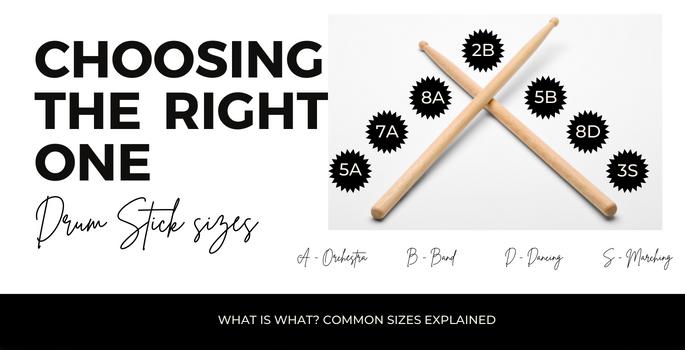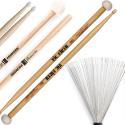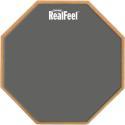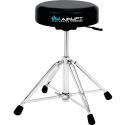Drum Stick Sizes Explained - Which Should You Use?

Learn about drum stick sizes & their common uses, and know which stick size fits your playing style and preferred genre.
Drumsticks come in a range of sizes which affect the overall sound they can create. No matter which sticks you pick up, you'll see a combination of numbers and letters to help identify their weight and thickness.
Once you know the terms, you look at these figures and judge if they're good for you without picking them up. Handy when buying drum sticks online!
What The Drum Stick Letters and Numbers Mean
Your drumstick will have one of 4 letters attached to them:
-
A - Orchestra
-
B - Band
-
S - Marching (or Standing)
-
D - Dancing
Orchestra is a thicker stick designed to create the boom needed in this playing style.
Marching bands would use the S version as they are lighter sticks.
These musicians need to walk and play simultaneously, and their drumming style is normally quick, so a lighter stick is necessary.
Band sticks are the middle ground being A and S. They need to allow quick movement and loud booms.
Dance sticks are the lightest of them all, designed for quick-fire movement.
These letters once had real importance in the music industry, but now they are considered old-fashioned. You can ignore the letters and still have a good stick balance.
What The Drums Stick Numbers Mean
The numbers tell you how long and thick your stick will be.
Number 1's are long and thin sticks, while number 9's are heavier sticks with a large thickness.
The Most Common Combinations And Their Uses
Most drummers will keep to an A or B, staying around the 3-6 range. Here are some standard drumstick sizes and their common use.
The 5A is the standard drumstick size. It can be used in all areas of the drum kit world, including electronic drum pads and electronic drums.
Although the A suggests orchestral music, it will sound great on any performance type.
The second most common drumstick sizes are 3A and 5B. 3A is slightly thicker and longer than the 5A, which gives it more power. It could be great for a concert band.
5B, however, is shorter than the 5A and slightly thicker than the 3A.
This change makes the perfect stick for a fast-playing style that still needs a heavy boom.
If you need a longer stick with a thinner size, you should go for the 7A. Many use this as their starter stick for jazz drumming. They then change sizes as needed. This stick is great for a lighter sound.
The last common choice that many drummers gravitate towards is the 2B.
2B's are the thickest stick available and the heaviest stick too. Most drummers prefer to avoid the depth this stick can create, but it is the perfect choice for metal bands.
Best Drum Stick Sizes Based On Genre
I have already touched on a couple of music genres such as classical/orchestral, jazz, and metal, so let's dive into the more popular music genres.
Rock Music
The best drumstick sizes for the rock music genre are 5Bs and 5As. These signature sticks have a natural sound and are incredibly durable - perfect for an impulsive throw!
Experienced drummers may prefer nylon drumstick tips like Vic Firth American Classic 5AN - Nylon Tip. They prefer it over classic drumstick wood as it can create a brighter sound and an easy bounce to help them reach their next hit. Generally speaking, wooden tips can work just as well - they are less expensive and hardier than nylon tips. Note that there can be variations in terms of sound and feel depending on the type of wood used.
Pop Music
Pop musicians, much like rockers, should use 5Bs. Drumstick weight is heavy enough to create a warm sound, even with a nylon tip.
Country Music
Country musicians should use a mixture of 5A wooden rods and brushes. Brushes are a different kind of drumstick tip material. They create softer music for light and upbeat unique sounds.
Indie Music
Indie musicians should stick to 5As. They have a brighter cymbal sound which matches the genre, and the drumstick length allows for both low smooth sounds and quick changes. You should also pick wooden tips for a warmer sound
Dance Music
Dance musicians are the only common musician type to avoid the 5As and 5Bs. They should pick completely different sticks - the 7A.
Dance music needs to be upbeat, quick, and light of sound. The 7A is the longest stick, so it can easily achieve quick movements and reach different styles of drums, or be used on multiple drum setups.
Frequently Asked Questions
Which is the thicker stick? 5A VS 7A?
7A is designed for acoustic performances, such as Jazz. 5A is a thicker and heavier stick alternative. Thicker sticks sound fuller but will require a bit more effort to play. Lighter sticks are easier but can lack in the fullness department.
What Size Drum Stick is Good for A Beginner Drummer?
Students should pick either a 5A or a 5B stick with wood tips, they are perfect for pairing with a beginner drum set. Don't bother looking at the drumstick tip shapes yet, instead consider the weight and ease of movement from these standard sticks. Tip shape will become more important as you gain more experience.
What are Nylon Tips? Is Drumstick Tip Material and Tip Shape Important?
Drumstick Tips, also called drumstick beads, substantially affect drum sound. And each one can have their own distinct bounce and playing feel. The difference can go from subtle to substantial depending on the material type and playing technique.
Nylon tips are preferred by heavy hitters because of its highly durable and resistance to chipping or breaking. But note that some drummers find it to be too bright sounding. Some of the feel and bounce is also lost, compared to stick with wood tips like hickory drumsticks. Other important considerations include tip shape (barrel, acorn, ball and oval tip) and drumstick taper. These specifications also impact feel and sound, but it's a topic that's better discussed in its own article.
Final Thoughts
Choosing drumsticks shouldn't be hard, as the differences between types of drumsticks are minimal.
If you're completely lost, pick a 5B and test out the foundation. Need something lighter? Go thinner. Need something with a larger boom? Pick a thicker version.
With these drum stick sizes explained, you can play around to find the right balance for you.












